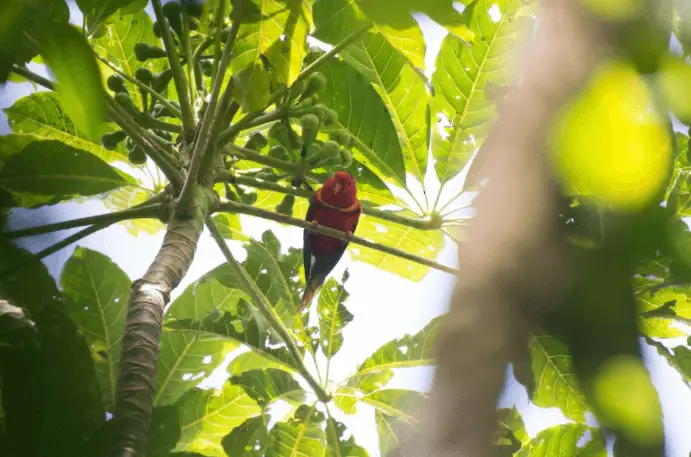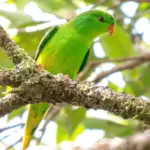
Duchess Lorikeet 20 cm; 40–60 g. Mid- to hind crown blackish, rest of head, throat, and nape red; complete yellow ring, bordered on both sides by dull black, from breast onto sides of the neck and upper back;
vent green; tail red-tipped yellow; upper back and wings green; lower back and rump olive green, red at sides; bill and legs orange.
Duchess Lorikeet Female has yellow at the sides of the rump. Immature has a less defined yellow ring, unbordered above, with dark scaling to body feathers.
Systematics History
Monotypic.
Subspecies
Monotypic.
Distribution
Solomon Is, including Bougainville, Gizo, Kolombangara, Nggatokae, Santa Isabel, Guadalcanal, Malaita, Makira (San Cristobal), Santa Ana, and Santa Catalina (Dutson 2011).
Habitat
Forests, second growth, and coconut plantations from sea-level into lower mountains up to 1350 m, apparently more numerous away from lowlands though considered most frequent at 100–600 m.
On Kolombangara and San Cristobal, lower densities are found in all lowland habitats including primary forest, the highest numbers on San Cristobal being at 500–700 m.
Movement

No information, but fluctuations in abundance would seem likely in response to the phenology of flowering trees.
Diet and Foraging
Duchess Lorikeet Pollen, nectar and blossoms, and soft fruit, especially epiphytic Schefflera.
Sounds and Vocal Behavior
Duchess Lorikeet Calls in general squeakier, lower-pitched, and less shrill compared to congenerics.
Calls include a squeaky “kyeet”, a fast “kyi-ki-ki” and lower-pitched squabbling notes. Larger flocks are quite noisy, emitting constant chattering.
Breeding
Display by a male to female observed, Jan; gonads of collected birds inactive in Jul, although locals report breeding at that time.
Conservation Status
Not globally threatened. CITES II.
Currently considered Near Threatened. A BirdLife “restricted-range” species. Widespread and fairly common at least on Kolombangara, Guadalcanal, and Bougainville; uncommon on Santa Isabel; common on San Cristobal, possibly owing to the absence of C. meeki.




















